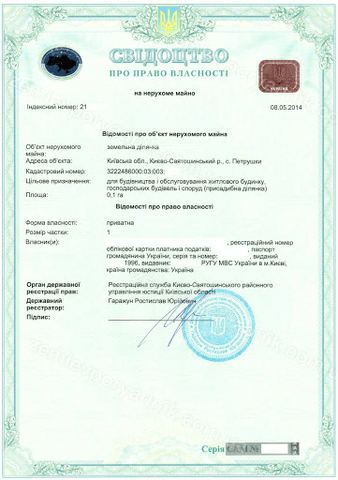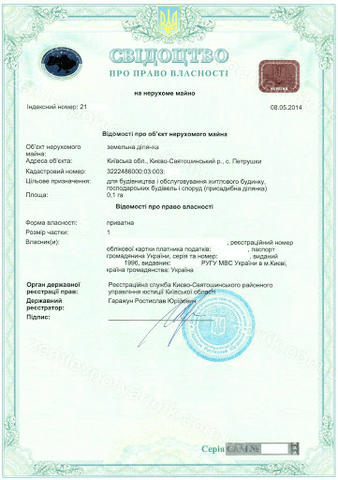Division and consolidation of land plots: main stages and requirements
Cost of services:
Reviews of our Clients
Ukraine, blessed with its fertile soil and substantial agricultural potential, possesses significant land resources that are central to various economic activities. One of the key aspects of managing these land assets involves the partition and amalgamation of land parcels. These procedures are garnering increasing attention from landowners, lessees, developers, and real estate professionals because they offer vast opportunities for optimizing land utilization and executing diverse projects.
For landowners, partitioning can serve as a tool to efficiently allocate and transfer land assets among heirs or partners. This facilitates the preservation of rights' clarity and effective land management while upholding land integrity.
Conversely, the amalgamation of land parcels can be a pivotal step in realizing various construction and development projects. For builders and developers, this process unlocks the potential to create more extensive and efficient land areas for ambitious endeavors, whether they involve residential complexes or commercial ventures.
In this article, we will delve more deeply into the intricacies of land partitioning and amalgamation. We will explore the legal dimensions, procedures, and prerequisites associated with these processes. Furthermore, we will examine specific cases that illustrate successful applications of land partitioning and amalgamation, drawing from our extensive experience in providing legal services in the field of land law.
You may also like: Land Rights During Ukraine's Wartime: Privatization, Disposal, and Change of Land Use
The key steps and requirements for land plot division
A land plot gains legal status upon its formation. When a land plot becomes legally established, you can enter into various civil contracts related to it, without any legal restrictions for specific land categories. This includes actions like inheriting, gifting, or constructing on it.
A land plot is considered formed when it is assigned a cadastral number, and its information is registered in the land cadaster. Since Ukraine gained independence, procedures associated with land plot registration and the documentation confirming their formation and ownership rights have shown significant variation. In some cases, land plots with ownership (or usage) rights that originated before 2004 are considered formed, regardless of whether they were assigned a cadastral number.
How can new plots be created from one, or one plot from two or more? This is achieved through their division or amalgamation via land planning documentation. Furthermore, during the process of amalgamation or division, you can modify the land plot's designated use by developing a land planning project for land allocation.
Key aspects and requirements for dividing or merging land plots are as follows:
- Initiation by the owner's decision.
- Mandatory notarized consent from the land user or mortgage holder (if the land is in use or under mortgage).
- When division/consolidation is conducted in accordance with the law, documents confirming consent are submitted to executive authorities or local self-government bodies.
- Parcels intended for consolidation must share the same land use designation.
- After division, the parcels retain the land use designation of the original parcel.
- Establishing sublease or easement for a portion of a land plot does not necessitate the creation of a new parcel within that portion.
- Property rights on the plot are registered only after its details are recorded in the land cadastre.
- The parcel subjected to division or consolidation ceases to exist as an object of civil rights, and its information is archived in the cadastre.
- If specific encumbrances or restrictions were placed on the parcel, they are transferred to the newly created plots.
- During division or consolidation, new cadastral numbers are assigned to the newly formed plots.
A client, involved in constructing houses for sale, approached us with a unique scenario. They possessed a single land parcel and aimed to build two houses on it. However, regulations typically permit only one house on a single parcel. To construct and sell multiple residential houses as separate properties, the land needed to undergo division.
To accomplish this, the client applied for notarized certification of a distribution statement. Subsequently, we prepared the required land management documentation, resulting in the creation of two distinct land parcels. We obtained extracts from the State Geocadastre and successfully registered property rights for the newly formed parcels.
You may also like: How to Verify a Land Plot in Ukraine Before Purchase?
Combining and Dividing Plots for Obtaining a Construction Passport or Urban Planning Conditions and Restrictions during Construction
Our clients often inquire about building multiple residential houses on a single suburban land plot or constructing a single residential house on several plots. The construction of an individual residential house, garden cottage, or dacha, not exceeding two stories (excluding the attic), with a total area of up to 500 square meters, can be carried out based on an individual residential building permit.
An estate typically encompasses the primary residential house along with auxiliary buildings and structures. Since the main dwelling is the central component, the construction of individual residential houses, garden cottages, or dachas on multiple adjacent land plots can be achieved by either merging these plots into one or obtaining multiple individual residential building permits to accommodate houses and auxiliary structures on separate land plots.
The individual residential building passport outlines a comprehensive set of rules and requirements governing the construction of residential houses (estates), garden cottages, or dachas. This includes provisions not only for the primary dwelling but also for auxiliary structures, garages, landscaping elements, and beautification aspects of the land plot. It's crucial to emphasize that the term "house" within this context refers exclusively to a single residential dwelling.
Please note! The current legislation does not permit the construction of multiple residential, dacha, or garden houses on a single land plot.
On one land plot, it is only permissible to construct one residential house, which is considered the primary real estate unit. All other structures or buildings located on the same plot are considered part of this main property. Therefore, to build two or more residential, cottage, or garden houses on one land plot, several steps must be taken:
- Divide the land plot into separate sections.
- Assign a unique cadastral number to each newly created land parcel.
- Register property rights for each of these land parcels in the property registry.
- Obtain the necessary building permits for each individual land parcel to enable construction.
You may also like: How to Buy Land in Ukraine with the Assistance of a Lawyer?
What is unclaimed (undistributed) land parcels, and how legislation regulates their allocation and future
During the privatization of agricultural land from state-owned farms, these land parcels are provided free of charge to the employees of these enterprises, as well as to employees of educational, cultural, and healthcare institutions located within the territory of the respective local council. These individuals are allocated a specific share of the land, known as a "land share" or "land allotment."
The right to a land share is granted to:
- Former members of state and communal agricultural enterprises who have received certificates entitling them to a land share.
- Heirs of such individuals.
- Ukrainian citizens and legal entities who, in accordance with Ukrainian legislation, have obtained the right to a land share.
- Employees of state and communal educational, cultural, and healthcare institutions located within the territory of the respective local council.
- Individuals whose right to a land share has been established by a court decision.
Certificates for the right to a land share (land allotment), inheritance rights certificates, court decisions, sale, gift, and lease agreements, all properly executed in accordance with legal requirements, serve as documents confirming one's entitlement to a land share. Additionally, these documents are accompanied by a certificate for the right to a land share.
Currently, there are undistributed land parcels and unclaimed land shares (land allotments). Undistributed parcels refer to lands not allocated to the owner of the land share in accordance with the land parcel distribution protocol. Unclaimed refers to a parcel for which no ownership document has been obtained, or for which such a document exists, but the parcel has not been physically allocated on-site.
If by January 1, 2025, the owner or their heir possesses an unclaimed land share, they will be considered to have renounced ownership of the land parcel. Such a parcel will be transferred to communal ownership based on a court decision regarding the transfer of ownerless property into communal ownership.
The legal team at Pravova Dopomoga Law Firm is ready to provide a wide range of services, including the division and consolidation of land parcels. Our services go beyond traditional land surveying, as we offer a broader spectrum of actions aimed at satisfying the client's needs.
Here are the services we offer:
- We analyze our client's situation and their intentions regarding land use objectives.
- We review the initial data, urban planning documentation, and building restrictions.
- We develop an action plan (roadmap) that encompasses not only land transactions but also the future use and development of the land parcel.
- We provide legal and technical support throughout the division process to ensure that the newly formed land parcels align with the client's objectives.
- We assist with the notarization of documents required for division.
- We oversee the division of any real estate located on the land parcel.
- We handle the registration of ownership rights for the newly formed parcels on behalf of the client.
We take a personalized approach, offering preliminary consultations and document analysis to clarify the feasibility of these actions. Additionally, we extend our support to construction and farming projects. Don't hesitate to get in touch with us for top-notch legal assistance tailored to your specific needs.





